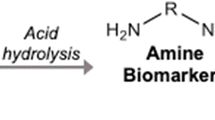Abstract
Head-space gas chromatography (GC) and high-performance liquid chromatography (HPLC) (with fluorescence detectors) methods were developed for toluene (TOL-U) and o-cresol (CR-U) in urine, respectively. In order to identify the most sensitive urinary indicator of occupational exposure to toluene vapor (TOL-A) among TOL-U, CR-U, and hippuric acid in urine (HA-U), the two methods together with an HPLC (with untraviolet detectors) method for determination of HA-U were applied in the analysis of end-of-shift urine samples from 115 solvent-exposed workers (exposed to toluene at 4 ppm as geometric mean). Regression analysis showed that TOL-U correlated with TOL-A with a significantly higher correlation coefficient than did HA-U or CR-U. With regard to the TOL-A concentrations at which the exposed subjects could be separated from the nonexposed by the analyte, TOL-U achieved separation at < 10 ppm TOL-A, whereas both HA-U and CR-U did so only when TOL-A was 30 ppm or even higher. The ratio of the analyte concentrations at 50 ppm TOL-A to those at 0 ppm TOL-A was also highest for TOL-U. Overall, the results suggest that TOL-U is a better marker of exposure to toluene vapor than HA-U or CR-U.
Similar content being viewed by others
References
American Conference of Governmental Industrial Hygienists (1994) 1994–1995 Threshold limit values and biological exposure indices. ACGIH, Cincinnati
Antti-Poika M, Kalliokoski P, Hänninen O (1987) Toluene. In: Snyder R (ed) Browning's toxicity and metabolism of industrial solvents, 2nd edn. Elsevier, Amsterdam, pp 38–63
Deutsche Forschungsgemeinschaft (1994) List of MAK and BAT values 1994. VCH, Weinheim
Ghittori S, Imbriani M, Pezzagno G, Capodaglio E (1987) The urinary concentration of solvents as a biological indicator of exposure; proposal for the biological equivalent exposure limit for nine solvents. Am Ind Hyg Assoc 148:786–790
Gill R, Hatchett SE, Osselton MD, Wilson HK, Ramsey JD (1988) Sample handling and storage for quantitative analysis of volatile compounds in blood: the determination of toluene in headspace gas chromatography. J Anal Toxicol 12:141–146
Hirayama T, Ikeda M (1979) Applicability of carbon felt to the dosimetry of solvent mixture. Am Ind Hyg Assoc J 40:1091–1096
Ikeda M, Kumari M, Aksoy M (1984) Application of carbon felt dosimetry to field studies distant from analytical laboratory. Ind Health 22:53–58
Inoue T, Takeuchi Y, Hisanaga N, Ono Y, Iwata M, Ogata M, Saito K, Sakurai H, Hara I, Matsushita T, Ikeda M (1983) A nationwide survey on organic solvent components in various solvent products: Part I. Homogeneous products such as thinners, degreasers and reagents. Ind Health 21:175–183
Inoue O, Seiji K, Watanabe T, Nakatsuka H, Jin C, Liu S-J, Ikeda M (1993) Effects of smoking and drinking on excretion of hippuric acid among toluene-exposed workers. Int Arch Occup Environ Health 64:425–430
Inoue O, Seiji K, Watanabe T, Chen Z, Huang M-Y, Xu X-P, Qiao X, Ikeda M (1994) Effects of smoking and drinking habits on urinary o-cresol excretion after occupational exposure to toluene among Chinese workers. Int Arch Occup Environ Health 65:343–350
Jackson S (1966) Creatinine in urine as an index of urinary excretion rate. Health Phys 12:843–850
Japan Association of Industrial Health (1994) Recommended occupational exposure limits (in Japanese with English translation). Jpn J Ind Health 36:236–260
Kasahara M, Ikeda M (1987) Spontaneous desorption of organic solvents from carbon cloth. Ind Health 25:73–81
Kawabata H, Esaki T, Kasai S, Furuki K, Asaeda T, Ukai H, Takada S, Tanaka K, Inui S, Ikeda M (1995) Environmental monitoring results in 422 organic solvent workplaces in 142 plants (in Japanese). J Occup Health 37 (Suppl):S421
Kawai T (1989) Urinary phenol as a marker of exposure to benzene (in Japanese). Aromatics 41:274–281
Kawai T, Mizunuma K, Yasugi T, Horiguchi S, Uchida Y, Iwami O, Iguchi H, Ikeda M (1991) Urinary methylhippuric acid isomer levels after occupational exposure to a xylene mixture. Int Arch Occup Environ Health 63:69–75
Kawai T, Yasugi T, Mizunuma K, Horiguchi S, Iguchi H, Uchida Y, Iwami O, Ikeda M (1992) Comparative evaluation of urinalysis and blood analysis as means of detecting exposure to organic solvents at low concentrations. Int Arch Occup Environ Health 64:223–234
Kawai T, Mizunuma K, Yasugi T, Horiguchi S, Ikeda M (1995) Toluene in blood as a marker of choice for low-level exposure to toluene. Int Arch Occup Environ Health 66:309–315
Kumai M, Koizumi A, Saito K, Sakurai H, Inoue T, Takeuchi Y, Hara I, Ogata M, Matsushita T, Ikeda M (1983) A nationwide survey on organic solvent components in various solvent products: Part II. Heterogeneous products such as paints, inks and adhesives. Ind Health 21:185–197
Mizunuma K, Kawai T, Horiguchi S, Ikeda M (1995) Urinary methylchloroform rather than urinary metabolites as an indicator of occupational exposure to methylchloroform. Int Arch Occup Environ Health 67:19–25
Nise G (1992) Urinary excretion of o-cresol and hippuric acid after toluene exposure in rotogravure printing. Int Arch Occup Environ Health 63:377–381
Rainsford SG, Lloyd Davies TA (1965) Urinary excretion of phenol by men exposed to vapour of benzene; a screening test. Br J Ind Med 22:21–26
Author information
Authors and Affiliations
Rights and permissions
About this article
Cite this article
Kawai, T., Mizunuma, K., Okada, Y. et al. Toluene itself as the best urinary marker of toluene exposure. Int. Arch Occup Environ Heath 68, 289–297 (1996). https://doi.org/10.1007/BF00409413
Received:
Accepted:
Issue Date:
DOI: https://doi.org/10.1007/BF00409413




